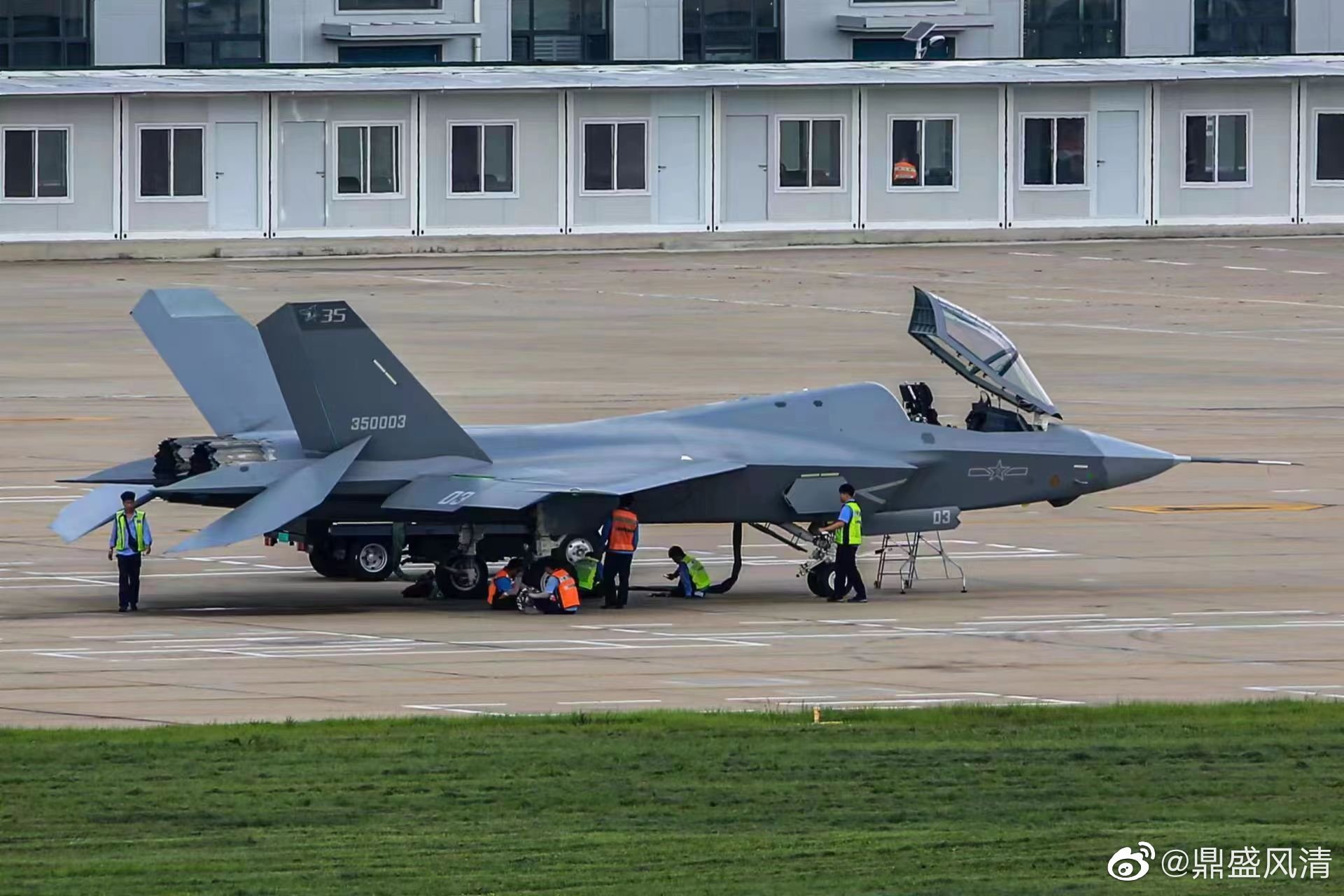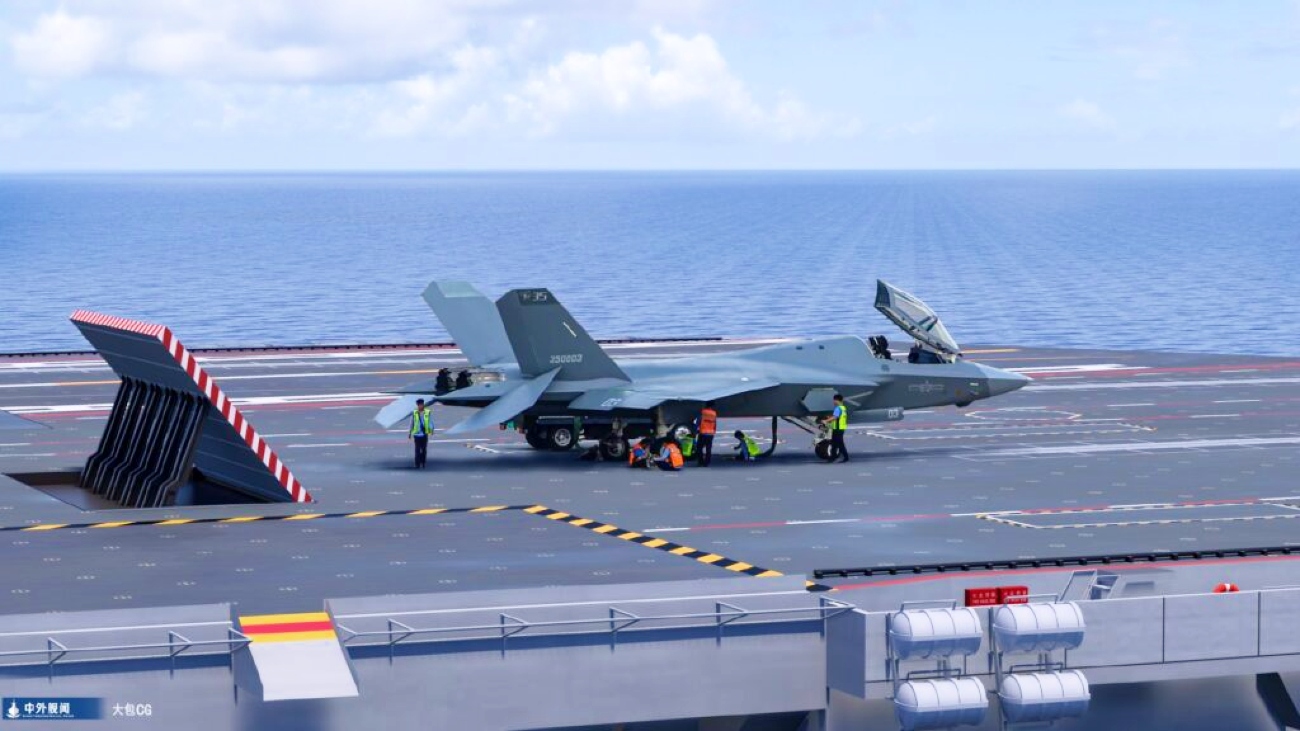China’s next-generation carrier-borne stealth fighter jet, the J-35, has reportedly commenced trial operations on the aircraft carrier CNS Liaoning. An Indian defense expert has warned that its potential deployment would pose an omnidirectional stealth threat to India’s security.
On September 18, Chinese state media announced the successful landing and takeoff of the J-35 from the aircraft carrier Liaoning, making it the first public acknowledgment of the aircraft’s operations on the carrier.
Footage released by China Central Television (CCTV) last week reported key tests aboard the CNS Liaoning, although the video did not show the J-35 taking off or landing.
In the footage, Zhang Naigang, a senior noncommissioned officer on the Liaoning, expressed pride and excitement over the new jet’s operations.
Zhang, who heads the takeoff section of the aircraft operations support department on the Liaoning, compared the event to the first takeoff of the older J-15 fighter from the ship.
https://twitter.com/ChinaDaily/status/1836223622706545127
While he refrained from providing specific details about the J-35’s performance or the trials, his remarks confirmed the jet’s initial deployment on the carrier.
The J-35, the carrier-based variant of the FC-31 stealth fighter, represents China’s bid to modernize its naval air capabilities and shift toward more advanced, fifth-generation aircraft.
US Pushes “F-22, F-35 Fusion” To Indian Air Force Under Make In India; Lockheed Boss Meets PM Modi
Rumors of a carrier-based variant of the J-35, also known as the FC-31, have circulated for years. In July 2022, some of the first images of the J-35 carrier prototype appeared online.

Furthermore, in February 2023, a video was released showcasing a young naval pilot preparing for a flight in what appeared to be a new carrier-based jet, further fueling speculation about the J-35’s development.
The stealth fighter is expected to replace the current J-15, China’s only operational carrier-based fighter, which has been in service for over a decade. The J-15, a fourth-generation aircraft, is known for its heavy weight, which limits its mission capabilities.
In contrast, the J-35 is estimated to be around 22,000 pounds lighter than the J-15, although it is heavier than comparable US naval fighters.
The lighter design is expected to enhance the jet’s agility, operational range, and payload capacity, potentially boosting China’s aircraft carriers’ combat effectiveness significantly. The new jet is expected to elevate China’s naval power projection and could alter the strategic balance in the Indo-Pacific region.
A Threat For India?
As China progresses with the trial operations of its next-generation carrier-borne fighter jet, the J-35, significant concerns have emerged within Indian defense circles.
Indian defense expert and veteran of the Indian Air Force, Vijainder K Thakur, has emphasized the implications of this development, describing it as an “omnidirectional stealth threat” to India’s national security.
A critical aspect of Thakur’s analysis pertains to the design of the Liaoning itself. Unlike most advanced aircraft carriers, which utilize Electromagnetic Aircraft Launch Systems (EMALS), the Liaoning relies on a ski-jump ramp for launching its aircraft.
He explained, “China’s third aircraft carrier, Liaoning, does not feature a catapult or EMALS. This means the FC-31 will undergo trials using ski-jump take-offs, evidence that it has a good power-to-weight ratio, as do the MiG-29K and Rafale-M.”
It was initially thought that the next-generation aircraft would operate from the CNS Fujian, China’s third aircraft carrier. However, the Fujian has made a significant technological leap by incorporating an advanced catapult launch system similar to that of the US Navy’s new Ford-class carriers. This upgrade allows the Fujian to launch aircraft carrying heavier payloads for its missions.

However, if China can effectively deploy its next-generation carrier-based stealth fighter from the Liaoning and Shandong aircraft carriers, it will greatly strengthen its naval air capabilities in the coming years.
Thakur further highlighted the concerning implications for India, stating, “The bad news for India is not just the fact that within 2-3 years India would likely see the Liaoning sail into the Indian Ocean with scores of stealth fighters, more ominous is the fact that by that time Pakistan would be all set to deploy land-based analogs of this fighter jet, FC-31 Gyrfalcon stealth fighter, customized for use by the PAF.”
J-31 Fighters: How Will Indian Air Force Respond To Pakistan’s Acquisition Of FC-31 Stealth Jets?
He expressed hope that, by that time, Hindustan Aeronautics Limited (HAL) would have stabilized production of the LCA Mk-1A, the indigenous Light Combat Aircraft intended to enhance India’s air capabilities.
However, as Thakur highlighted, the stealth threat extends beyond China. Earlier this year, Air Chief Marshal Zaheer Ahmed Baber, Chief of Staff of the Pakistan Air Force (PAF), announced the procurement of the Chinese fifth-generation FC-31 Gyrfalcon stealth fighter aircraft.
This development immediately raised considerable apprehension in India, where the domestic initiative to create stealth aircraft has been advancing at a sluggish pace, resulting in doubts regarding its capability to meet deadlines.
While India is in negotiations with France to acquire 26 Rafale Marine (Rafale M) fighter jets to replace its aging MiG-29s, the delivery of these jets will take years, as the contract between France and India has yet to be finalized.
The acquisition of the Rafale M jets is seen as a critical step in modernizing India’s naval aviation capabilities, enhancing its ability to operate effectively in maritime environments amid increasing regional tensions.
However, the delay adds to India’s challenges in rapidly modernizing its air fleet, particularly in the face of evolving threats in the region.
To top it all, the Indian Air Force (IAF) is grappling with the challenge of maintaining its fighter squadron strength, especially as its fleet faces the gradual phase-out of older jets, coupled with delays in the ordering and procurement of new aircraft.
On the other hand, China has already mass-produced the J-20 stealth aircraft and deployed it across various operational fronts. The J-20 program has advanced impressively since its inception, with approximately 250 aircraft produced, of which over 200 are currently believed to be in active service.
- Contact the author at ashishmichel(at)gmail.com
- Follow EurAsian Times on Google News




